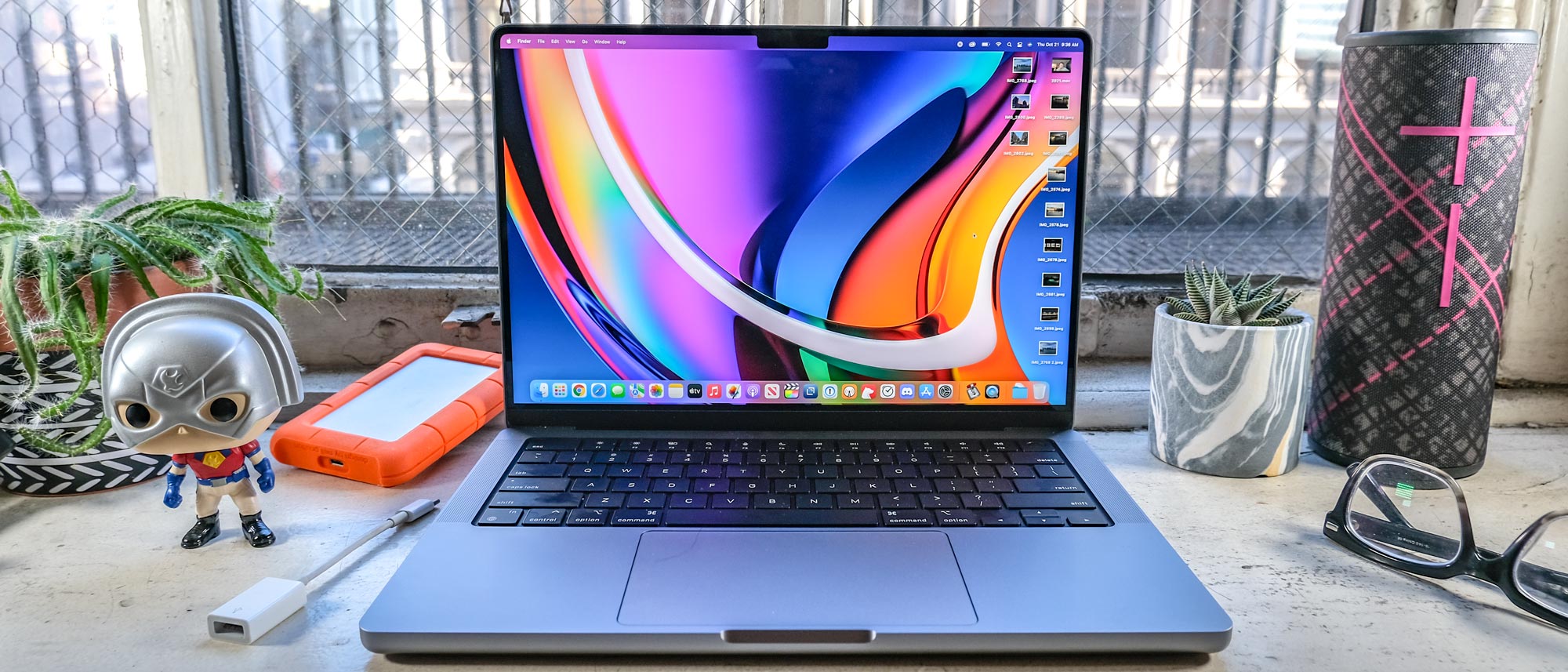Tom's Guide Verdict
The MacBook Pro 2021 (14-inch) is the long-lasting super-fast laptop many have waited for.
Pros
- +
Blisteringly-fast performance
- +
Gorgeous mini-LED display
- +
Epic battery life
- +
HDMI, SD memory and MagSafe return
- +
Comfy Magic Keyboard
- +
1080p webcam
Cons
- -
No USB-A port
- -
No update to $1,299 model
Why you can trust Tom's Guide
Editor's Note: Apple has released a new version of this laptop. See our full MacBook Pro 14-inch 2023 review with M2 Pro and M2 Max chips.
The Apple MacBook Pro 2021 (14-inch) is still an important laptop. And that's not only because of what it has but also for what it erases. The marquee features start with the M1 Pro chip, a seriously super-charged upgrade over the M1 chips that upped speeds and battery life last year.
Then, there is the Liquid Retina XDR display, which offers improved contrast and refresh rates. Apple has also brought MagSafe charging — a safer way to refuel — back to the MacBook Pro.
As for what we're happy to see gone? Apple's shrunk the MacBook Pro display bezels down significantly (though it found a notch that caused trouble underneath) and thrown out the Touch Bar. Both of these changes would have been applause lines had Apple revealed this laptop to the public and not on a live stream.
On top of that, we've got an HDMI port and an SD memory reader, two ports that the MacBook Pro hasn't had since 2015. So, this MacBook Pro 2021 (14-inch) review will show not just why this is one of the best laptops around, but a true return to form for the MacBook Pro.
If you're looking for a bigger screen, check out our 16-inch MacBook Pro review. If you want something a little smaller, the 13-inch MacBook Pro (M2, 2022) delivers that in an old-school design, with remarkable battery life — but few of the bells and whistles its larger siblings sport. Whichever you decide to buy, take a look at our list of 9 MacBook Pro tips everyone needs to know.
MacBook Pro 2021 (14-inch) review: Price and release date
- Pricey out the gate at $1,999
- The 13-inch MacBook Pro didn't get updated
This stings: the 14-inch MacBook Pro 2021 starts at $1,999. That's $200 more than the $1,799 MacBook Pro it replaces, though it adds a whole lot so it's not a huge issue.
Get instant access to breaking news, the hottest reviews, great deals and helpful tips.
That said, it's also $700 more than the 13-inch MacBook Pro with M1, which went without an update this year. For your two Gs you get the M1 Pro system-on-chip with an 8-core CPU (6 performance cores, 2 efficiency cores) and a 14-core GPU, 512GB of storage and 16GB of RAM.
Take a look at our Apple Store coupons page for ways to save.
The 14-inch MacBook Pro ships the week of October 25, 2021, alongside the MacBook Pro 16-inch (2021). Delays, though, are already piling up as demand skyrockets. These have only become worse with recent lockdowns and protests in China, so you may be in for up to an eight-week wait if you buy right now.
We really wish the lower-end 13-inch MacBook Pro had been updated along with these new models. That MacBook Pro is very similar to the MacBook Air, and there is a $1,000 gap between the MacBook Air and the new 14-inch MacBook Pro.
Maybe the updated 13-inch MacBook Pro's M1 Pro chip wouldn't be as powerful. Or Apple could have found another concession. Either way, its USB-C-only ports situation, thicker bezels and other similarities to the MacBook Air with M1 make that 13-inch model look like less of a MacBook Pro and more like a thicker MacBook Air.
MacBook Pro 2021 (14-inch) review: Specs
| Header Cell - Column 0 | 14-inch MacBook Pro 2021 |
|---|---|
| Starting price | $1,999 |
| Screen | 14.2-inch Liquid Retina XDR display (3024x1964 pixels, 254ppi) |
| Processor | M1 Pro (8-core CPU, 14-core GPU or 10-core CPU, 16-core GPU), with optional M1 Max with up to 10-core CPU and 32-core GPU |
| Battery size | 70Wh |
| Battery life (claimed) | Up to 11 hours of web surfing over Wi-Fi |
| Storage | 512GB to 8TB |
| Memory | 16GB to 64GB |
| Ports | Thunderbolt 4 (x3), HDMI, MagSafe 3, headphone jack, SD memory card slot |
| Webcam | 1080p FaceTime HD camera |
| Wi-Fi | 802.11ax Wi-Fi 6 |
| Bluetooth | Bluetooth 5.0 |
| Dimensions | 12.3 x 8.7 x 0.6 inches |
| Weight | 3.5 pounds |
The big story here is that the 14-inch MacBook Pro can still be customized with the M1 Max chip also seen in the MacBook Pro 2021 (16-inch). Plus, you can upgrade to a super-high 64GB of RAM and up to 8TB of internal storage. Of course, it gets more expensive if you do.
MacBook Pro 2021 (14-inch) review: Design
- Thinner bezels arrive with a notch in tow
- Lighter than Razer Blade 14 and heavier than XPS 13 OLED
The 14-inch MacBook Pro 2021 isn't just a new size for Apple's high-end laptops, it's also a part of a new era. For years, the MacBook Pro got very small, and pretty boring updates. This year? Nearly everything's different, as Apple's thrown out the tapered lid for a flat top, and even engraved "MacBook Pro" on the bottom.
More importantly, though, Apple's shrunk (most) of the MacBook Pro's bezels. Now, they measure a little more than 0.1 inches, down from the 0.5-inch (top) and 0.3-inch (side) bezels of the last three years. The Dell XPS 13 with OLED has similarly small bezels, and for longer, as its computers have had InfinityEdge display panels for years.
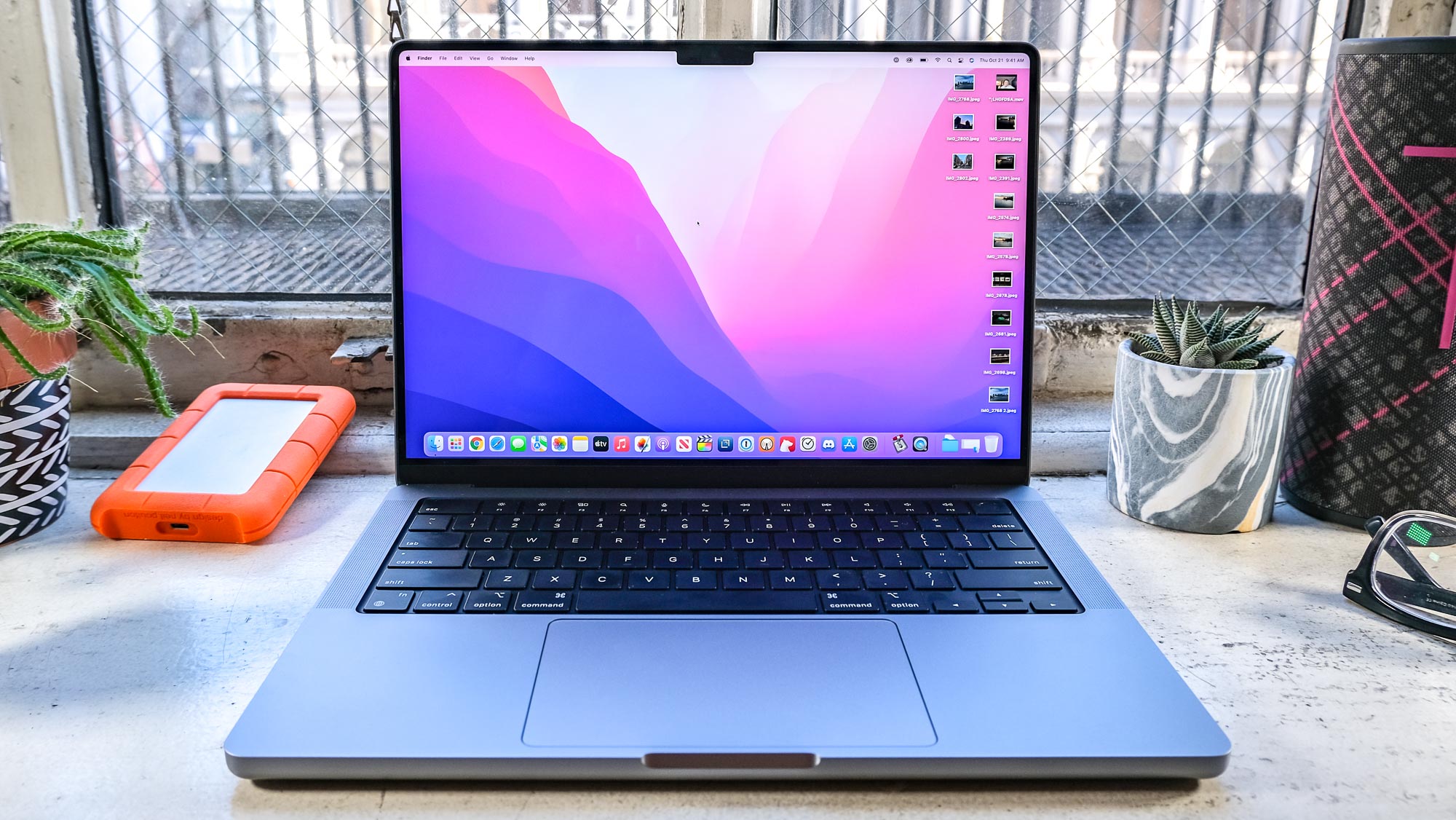
There is one exception, though: Apple gave the MacBook Pro a notch. Yes, the little black rectangular space for cameras in the iPhone made it to the top-center of the MacBook Pro display. It's 0.4 inches tall, and it's impossible to miss, at first sight that is. I've already gotten used to it, and I'm more than accepting of it. The thinner bezels allow Apple to move the Menu Bar to the freed up space, and the notch only drops down far enough to be in that menu bar.
Unfortunately, the MacBook Pro notch had become a problem for some. Tech enthusiast Quinn Nelson explained that he had issues with the iStat Menus utility when the Menu Bar options on the left and the icons on the right hit a breaking point. Thankfully, the MacBook Pro 2021 notch fail could finally be getting fixed via an OS update that will be available to all customers soon.
The only other "new" change is that the left and right vents, for heat and audio, are larger than before. It's something I bet I'll get used to.
Look at the 14-inch MacBook Pro side by side with the 13-inch 2020 MacBook Pro, and tell me you'd take the latter, with its smaller screen and thicker bezels. Sure, no notch would be better, but it's a decent compromise.
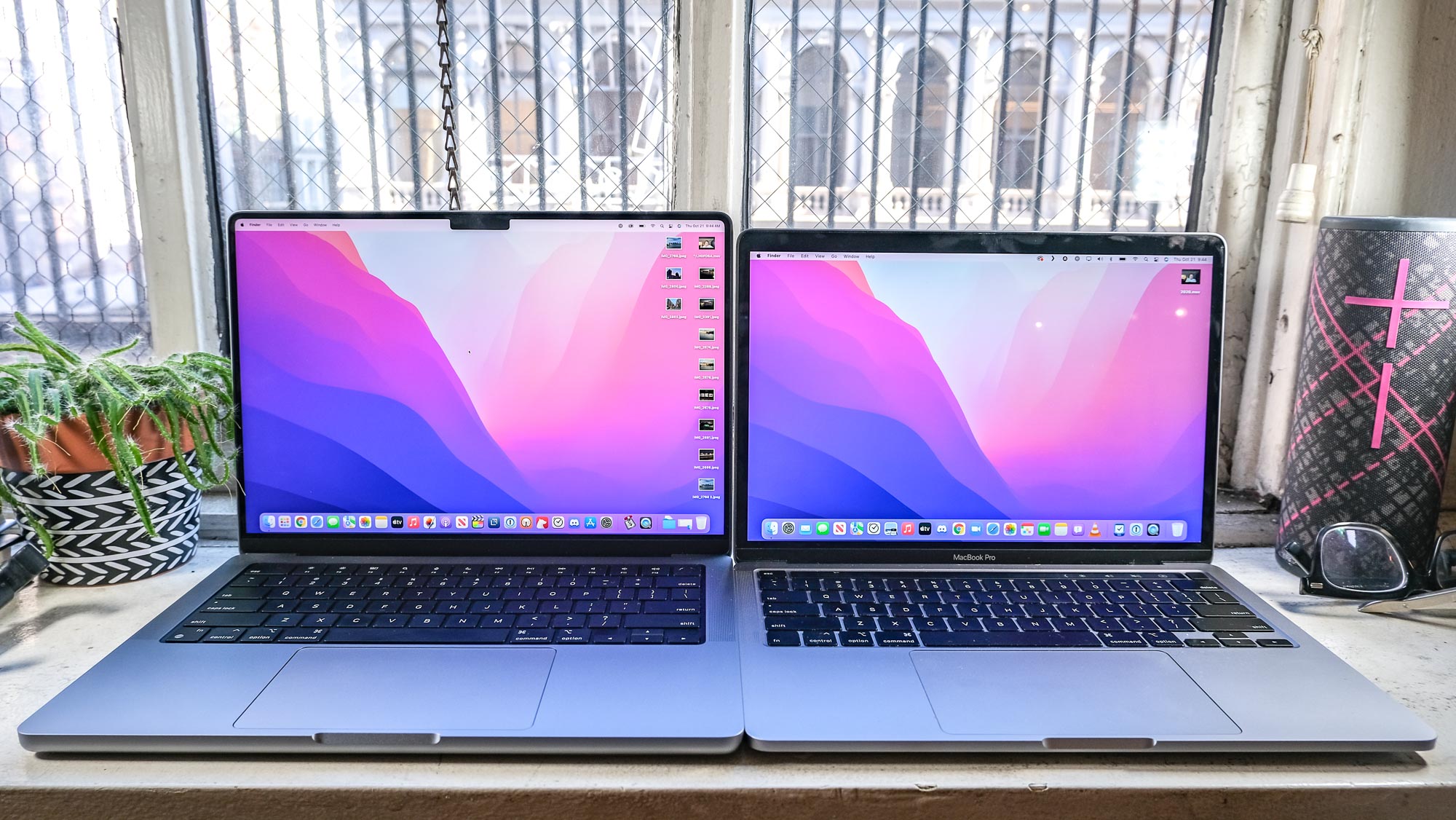
Measuring 12.3 x 8.7 x 0.6 inches and weighing 3.5 pounds, the 14.2-inch MacBook Pro is slightly larger and heavier than the 13-inch MacBook Pro with M1 (12 x 8.4 x 0.6 inches, 3 pounds). Interestingly, though, the 14-inch MacBook Pro is thinner, if you drill down to centimeters, where it's 1.55cm thick vs the 1.56cm 13-inch MacBook Pro. But whose eyes are going to perceive that?
The 13.4-inch Dell XPS 13 with OLED (11.6 x 7.8 x 0.5 inches, 2.8 pounds) is smaller and lighter, while the 14-inch Razer Blade 14 (12.6 x 8.7 x 0.7 inches, 3.9 pounds) is larger and heavier. Unsurprisingly, the new MacBook Pro 2021 (16-inch) (14 x 9.8 x 0.7 inches, 4.7 pounds) is larger and heavier.
You may also be considering the larger and heavier 14.4-inch Microsoft Surface Laptop Studio (12.7 x 8.9 x 0.7 inches, 3.8 - 4.0 pounds) and the Dell XPS 15 OLED 2021 (13.6 x 9.1 x 0.7 inches, 4.2 pounds), which have a little more power.
We'll excuse the Surface Laptop Studio's larger design, however, as it's got an easel-like touchscreen display that you can pull towards you. It's the kind of feature that we'd love to see Apple play with, though they'd need to accept touchscreen laptops into their hearts first.
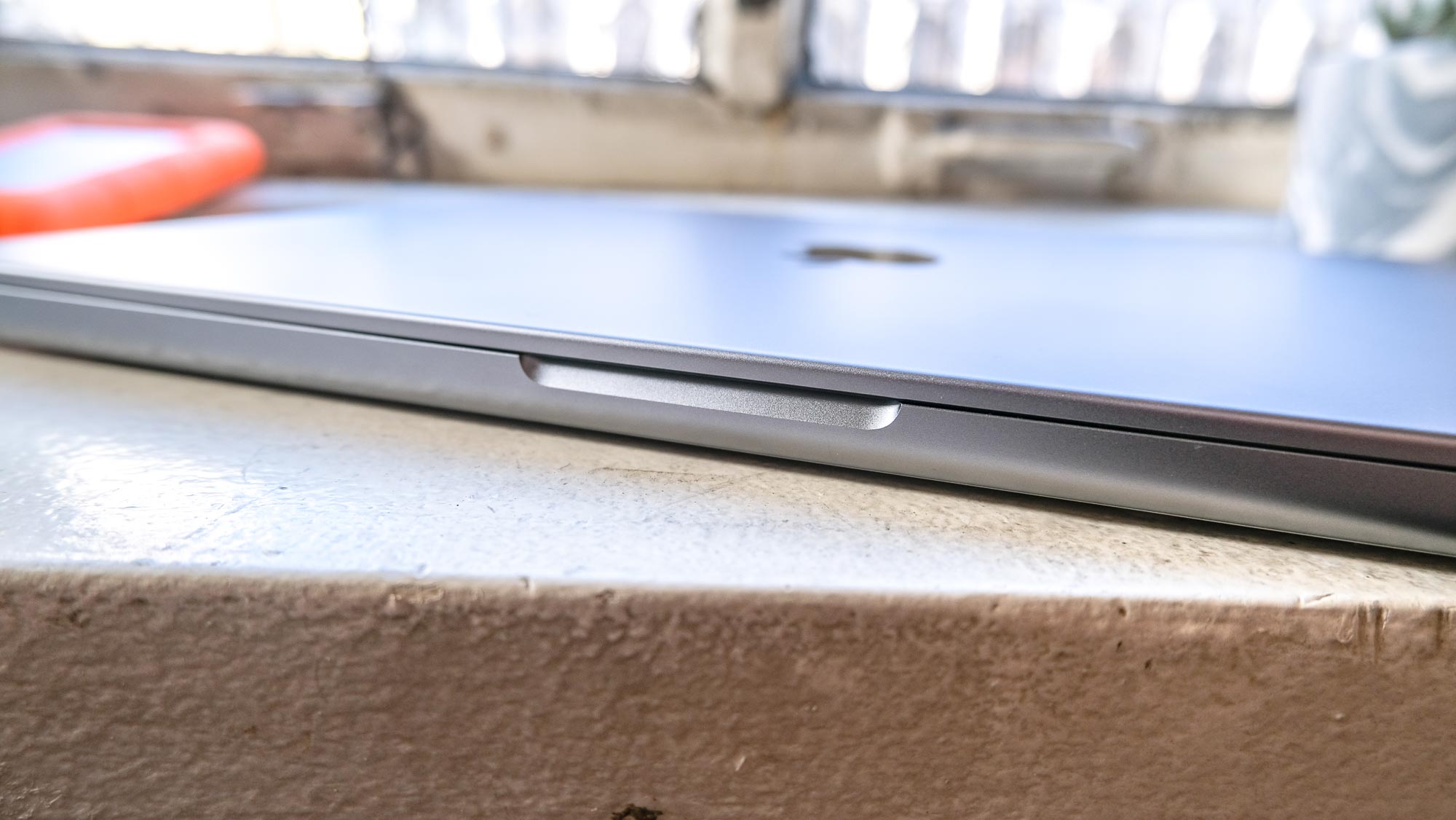
Apple sells the MacBook Pro 2021 in the same two colors they've sold MacBook Pros in for years: silver and Space Gray. I'm picking the latter when I buy mine, though I'll only see that color on the bottom half of the machine, as I'm covering the lid in stickers I've collected while waiting for the last five years.
MacBook Pro 2021 (14-inch) review: Ports
- The return of the MagSafe charging port, HDMI and SD memory reader
- Still no USB-A port
This is more like it. The 14-inch MacBook Pro 2021 trades Apple's previous philosophy — essentially "USB-C dongles are good enough" — for most of the ports that people need. One, though, is still in absentia.
On the left side of the MacBook Pro, you find arguably the most welcome port to return to the MacBook Pro: the MagSafe charging port. Apple (and its fans) spent years extolling the laptop-saving virtues of this magnetically-attaching power jack, which simply pops out whenever a more-than-minor amount of tension is applied. Previously, you could only charge the MacBook Pro via a USB-C cable, and those puppers could pull your laptop clear off your table — and where/how they'd land, who knows?
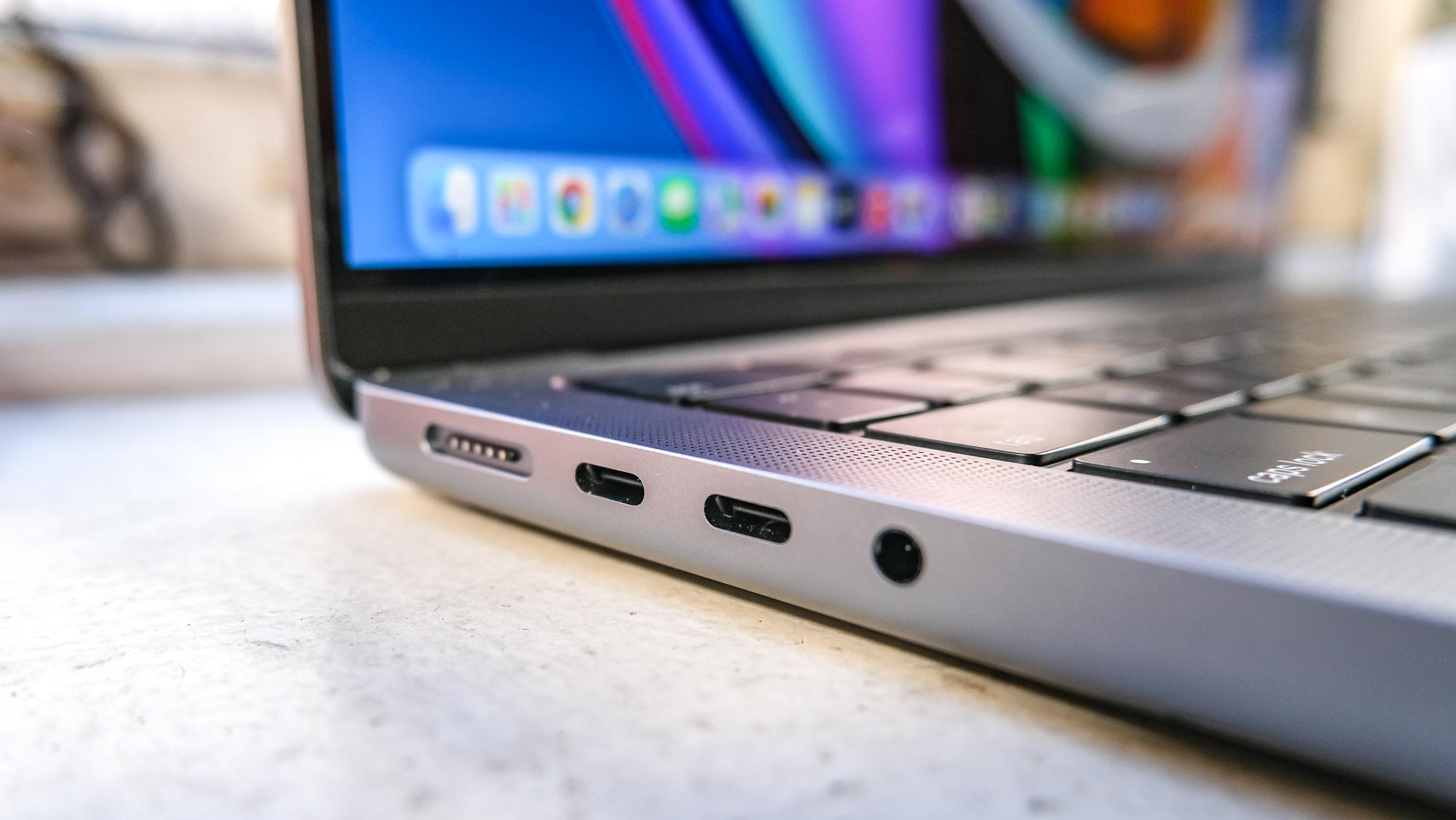
Alongside that, you've got two Thunderbolt 4/USB4 reversible USB-C ports, and a headphone jack that's been upgraded to support high‑impedance headphones that demand more power.
On the right side, you have a third Thunderbolt 4 port and two more ports that pros basically demanded return to the Mac: HDMI-out and an SD card reader. These are crucial for anyone who extends their display or plugs in a camera memory card (respectively). I've long used a USB-C hub dongle for this on my work-issued MacBook Pro, and I've long wished I didn't have to.
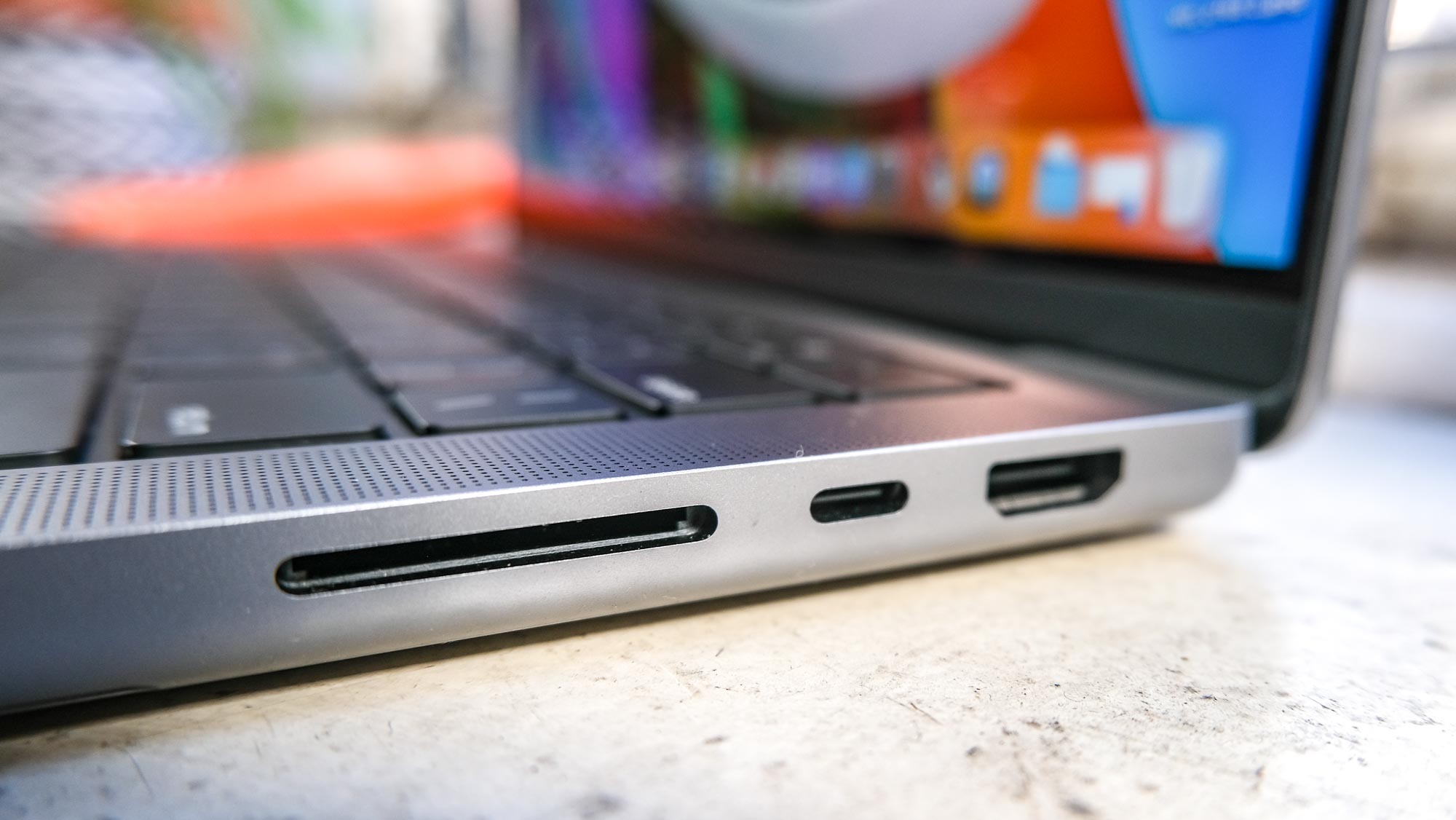
The SD reader supports the UHS-II format, which is basically "OK." It's faster than UHS-I and slower than the top-of-the-line UHS-III. Though to get that difference you need to buy SD cards that support UHS-II or UHS-III.
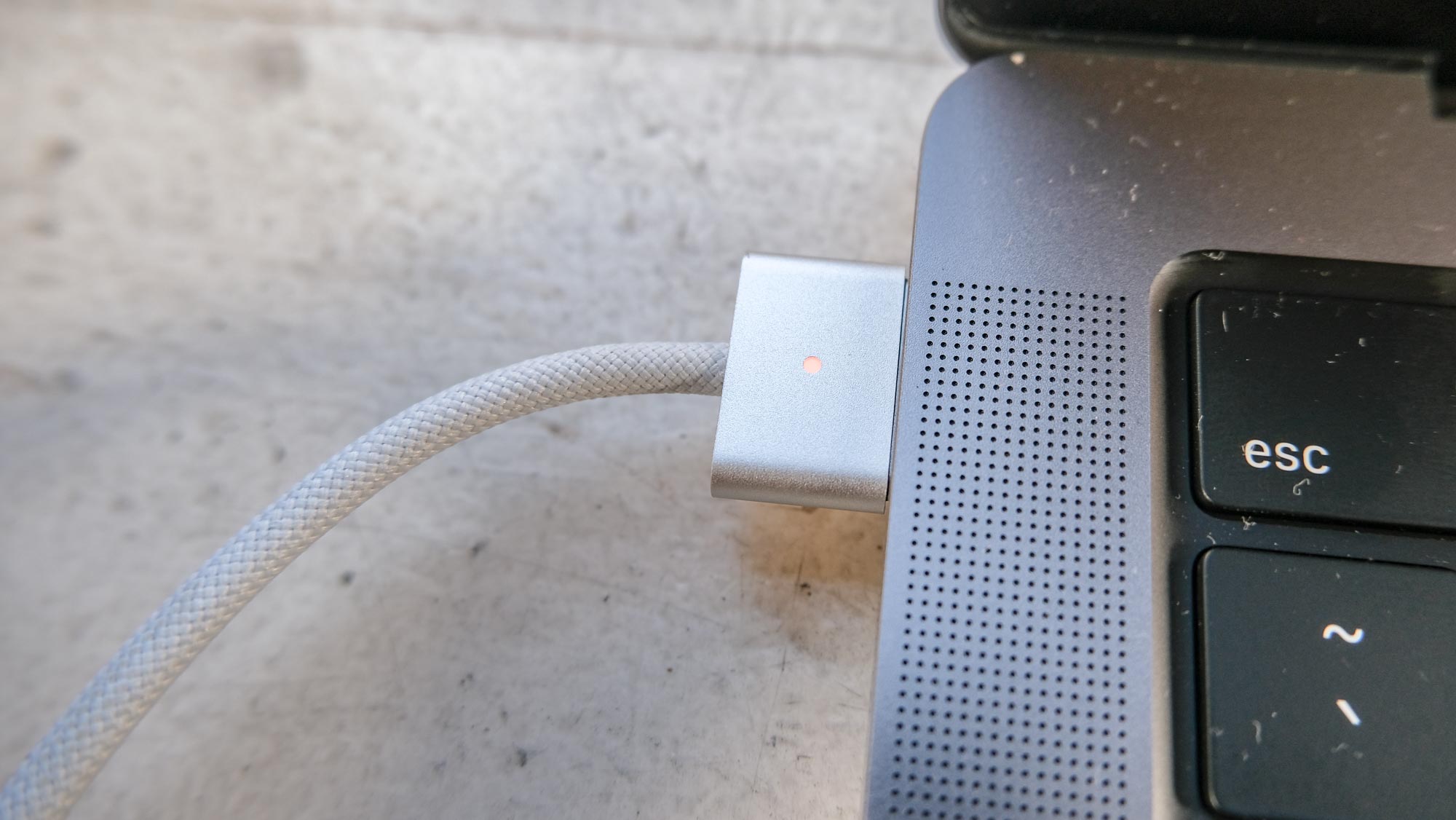
The 16-inch MacBook Pro has the same ports, while the 13-inch MacBook Pro just has two Thunderbolt / USB 4 ports and a headphone jack, making it a prime example of the input/output situation that pros were desperate to leave behind.
Both the Razer Blade 14 and XPS 13 come close to the new MacBook Pro port assortment. Both have dual USB-C ports and a headphone jack, while the XPS 13 has a microSD reader and the Razer Blade 14 has a USB-A port and HDMI. Dell throws in a USB-C to USB-A adapter, which Apple should be doing.
The XPS 15 has three USB-C ports and a microSD reader (it also chucks in a USB-A adapter), while the Surface Laptop Studio has dual Thunderbolt 4/USB-C ports, a headphone jack and Surface Connect port.
A USB-A port would be a welcome addition, especially as most people have at least one device that requires USB-A. I've got multiple: my Blue Yeti microphone, plus my wireless mouse and keyboard. Using these accessories on the go shouldn't require carrying an adapter with you.
Still not enough ports? Check out this new Plugable docking station that's great for multi-monitor setups.
MacBook Pro 2021 (14-inch) review: Display
- Plenty bright, with amazing contrast for HDR content
- ProMotion 120Hz refresh rate makes everything smoother
Everything just looks so much brighter and better on the mini-LED Liquid Retina XDR display in the 14-inch MacBook Pro 2021. Watching my 4K HDR copies of Scott Pilgrim vs. the World, Mission: Impossible - Fallout and Jordan Peele's Us, I repeatedly felt like I was seeing things better than I had in a while. I noted stunning contrast between the reds, blacks and whites in the final fight of Scott Pilgrim, as well as in lighting and shadows of the bathroom brawl in Mission: Impossible - Fallout and perfect beach tones in Us.
The other big feature in the MacBook Pro 2021 is its ProMotion 120Hz refresh-rate, which makes everything look smoother. This was seen not only in Tom Cruise and Henry Cavill's fist-fight in Fallout, but also when text simply looked better as I scrolled in the Apple News app and Chrome. Not every app works properly with it yet though, but 120Hz support for Safari and other apps are on the way.
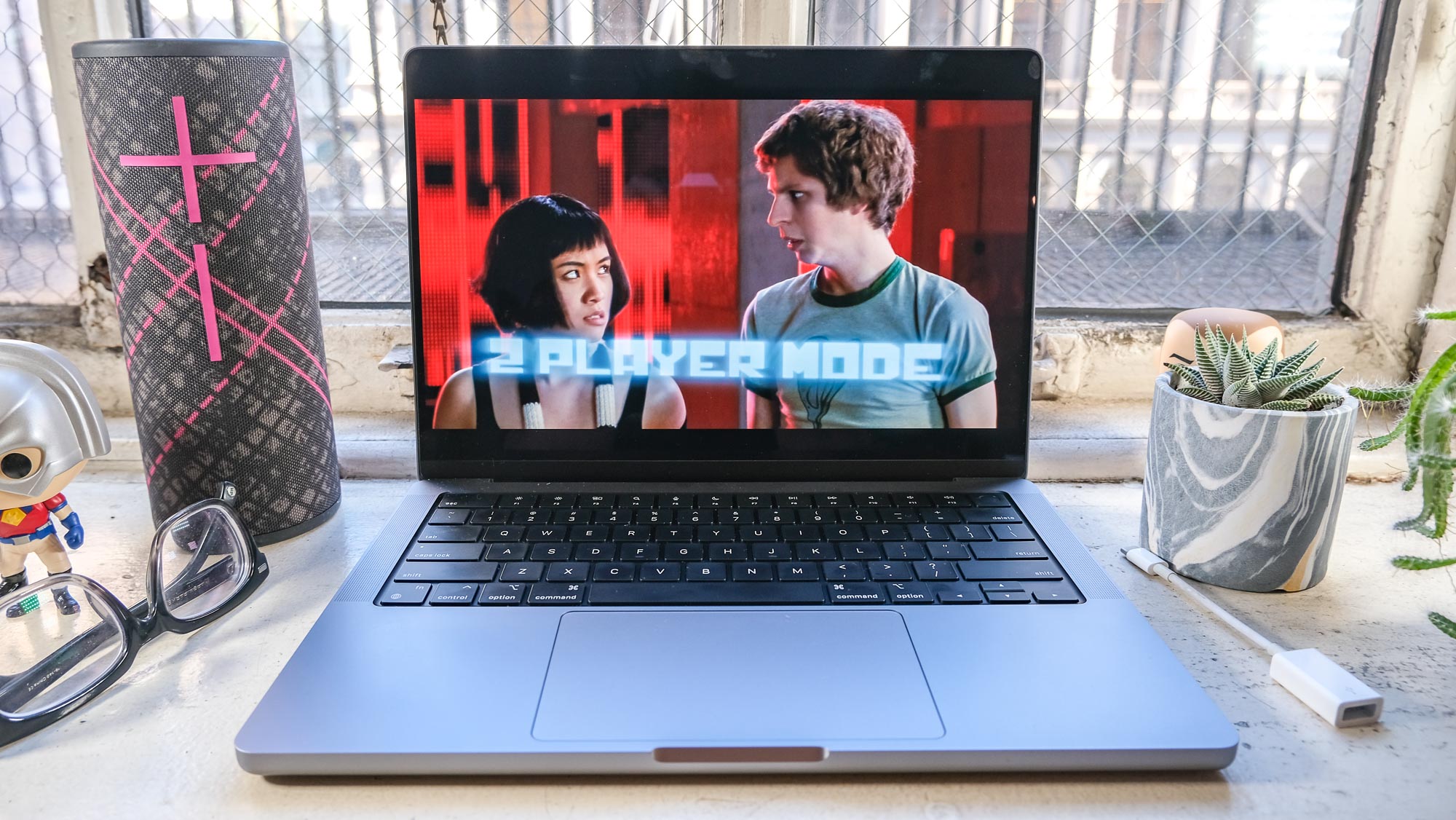
The 14-inch MacBook Pro's display produces 109.6% of the sRGB gamut (according to our colorimeter), which is within the margin of error of the score from the 16-inch MacBook Pro (109.3%). The Surface Laptop Studio (105.6%) hit a similar rate, the 13-inch MacBook Pro (111.8%) got a hair higher, as did the Razer Blade 14 (111.3%). The 3.5K OLED panel in the Dell XPS 13 (117.3%) hit a slightly greater number, while the 3.5K OLED XPS 15 panel (120.1%) is a notch above that.
The new MacBook Pros are super bright, with the 14-inch model emitting up to 487.8 nits according to our light gun (the 16-inch version reached a little higher, to 500.6 nits). The Surface Laptop Studio (487.2 nits) is similarly bright, while the 389-nit XPS 15, 439.4-nit MacBook Pro 2020, the 357.5-nit XPS 13 and the 332.4-nit Razer Blade 14 are dimmer.
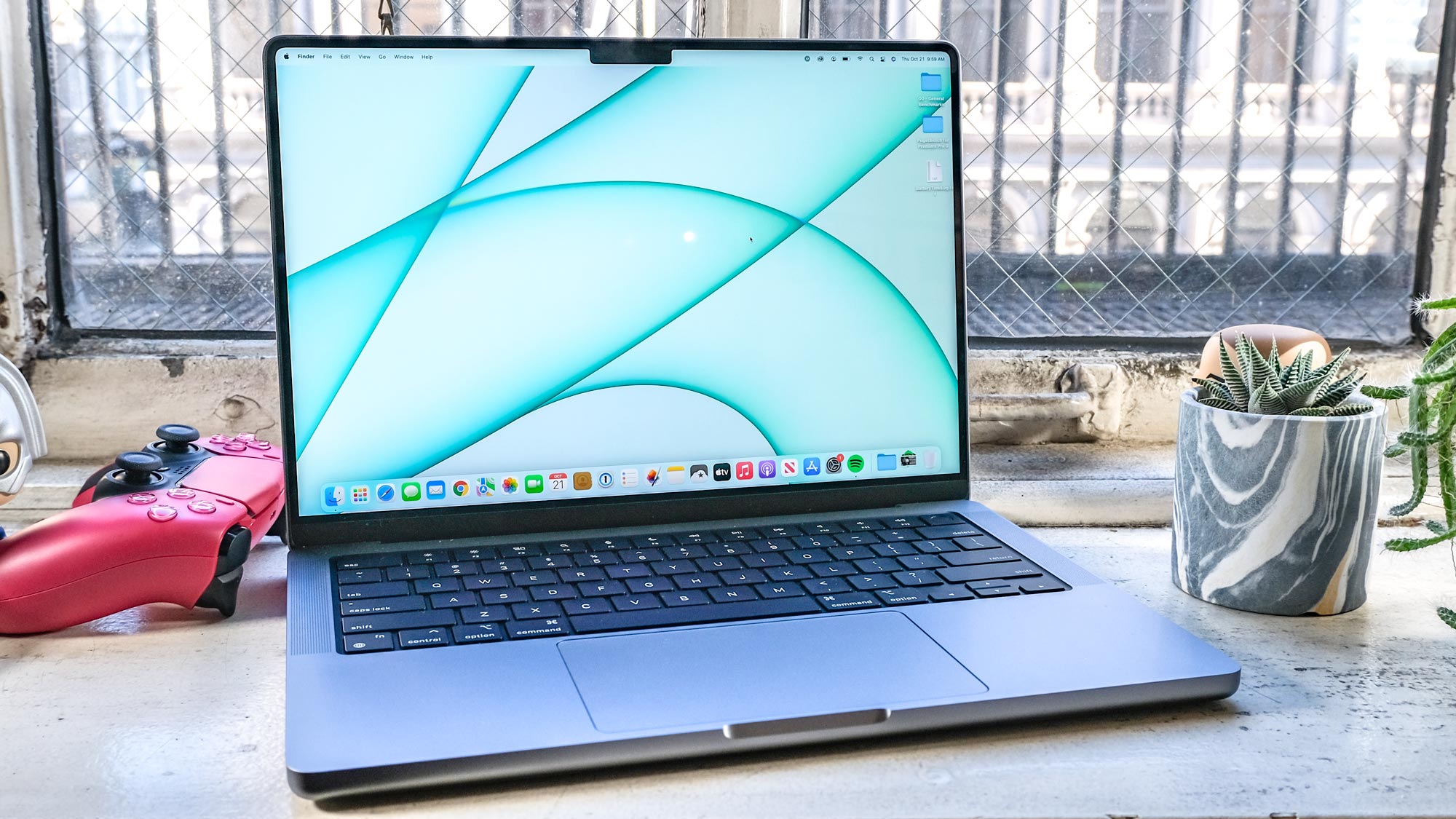
Apple rates the new MacBooks as hitting peak brightnesses of up to 1,600 nits, but the highest we could get it, when using tricks to try and amp up the brightness, was 520 nits. Still, this screen is amazing.
Be sure to read our guide on how to clean a MacBook screen to keep it looking its best.
MacBook Pro (14-inch, 2021) review: Performance
- M1 Pro system-on-chip is blazing fast
- SSD storage is speedier than ever
"How much faster could the M1 Pro get, really?" I thought to myself. Then we did the testing, and the 14-inch MacBook Pro (M1 Pro w/ 10-core CPU, 32GB RAM) blew the roof off the damn tests, like the Avengers lighting up Thanos from all angles. I've not even heard the fans ramp up as I've opened dozens of tabs in Chrome (also while splitting the screen with the 1080p trailer for Spider-Man: No Way Home).
On the Geekbench 5 general performance benchmark's multi-core test, the 14-inch MacBook Pro earned a whopping 12,477. The M1 Max-based 16-inch MacBook Pro (a 10-core CPU configuration, with 64GB of RAM) did a little better, at 12,683. Those scores practically walk right up to the 7,571 score from the M1 MacBook Pro 2020 (Apple M1, 8GB RAM) and shake it down for its lunch money.
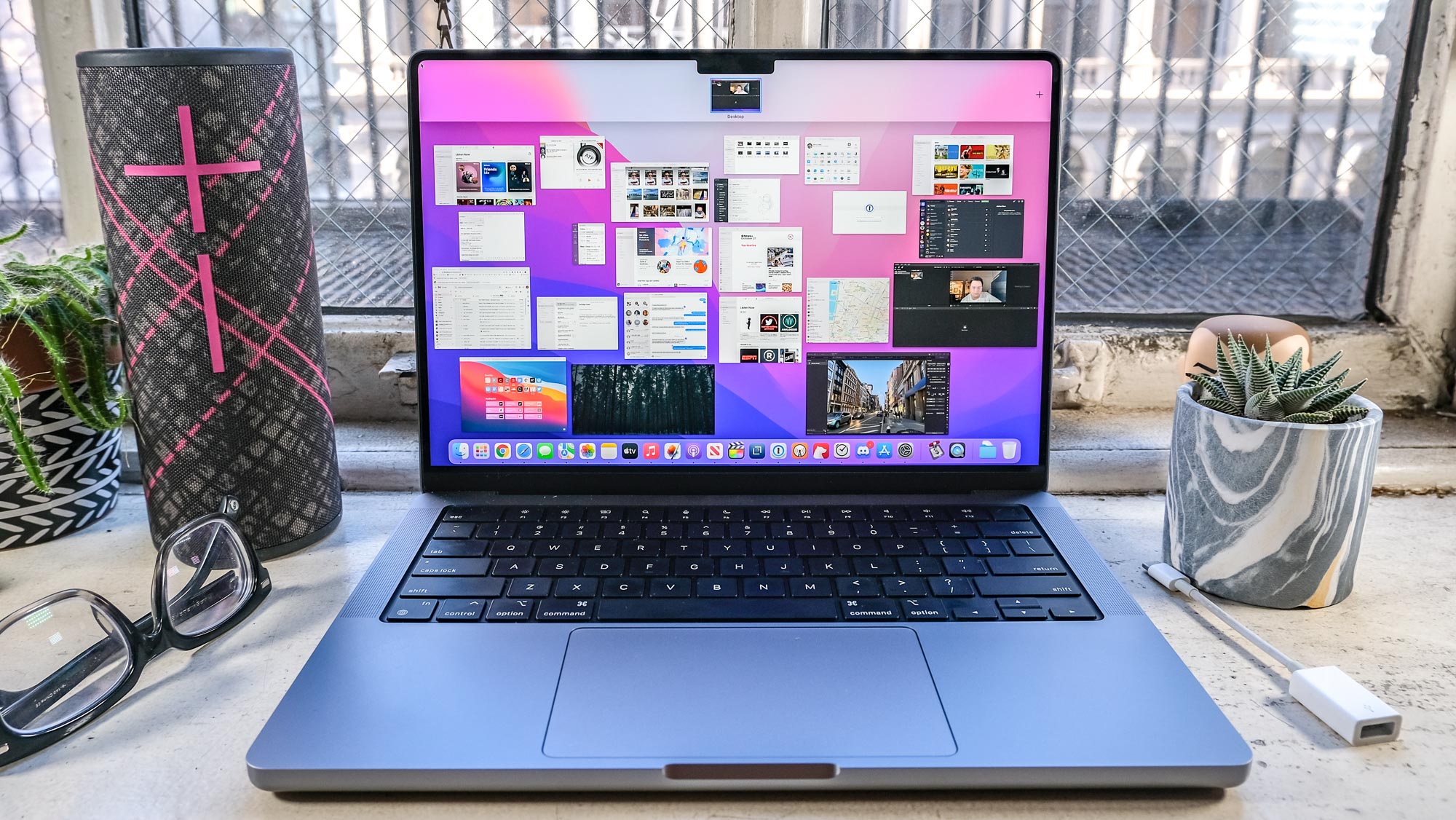
Similarly, the scores of 7,471 from the Razer Blade 14 (AMD Ryzen 9 5900HX, 16GB RAM), 7,477 from the XPS 15 (Intel Core i7-11800H, 16GB RAM), 5,820 from the Surface Laptop Studio (Intel Core i7-11370H, 32GB RAM) and 5,420 from the Dell XPS 13 with OLED (Intel Core i7-1185G7, 16GB RAM) now live under the tall shadow of the M1 Pro and M1 Max scores.
Admittedly, these new Macs have a leg up on some of these, with more RAM.
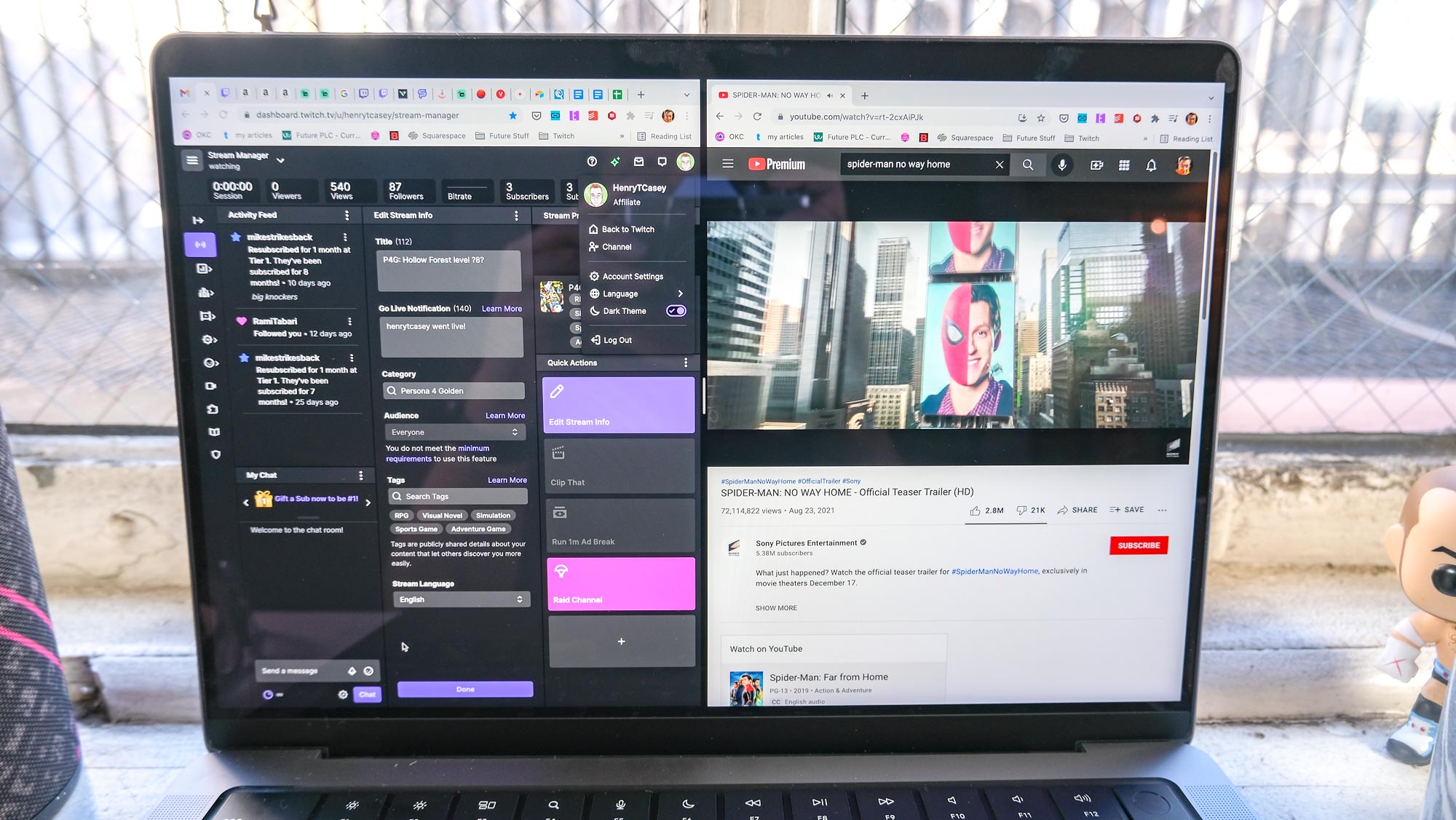
The M1 Pro-based MacBook Pro 2021 similarly super-charged scores on our Handbrake video encoding test, taking only 4 minutes and 51 seconds to transcode a 4K video to 1080p (the 16-inch MacBook Pro with M1 Max took 3 seconds less time, at 4:48). We got closer times of 7:46 from the 13-inch 2020 MacBook Pro, 7:20 from the Razer Blade 14 and 8:10 from the Dell XPS 15, while we saw much worse times of 11:24 from the Surface Laptop Studio and 18:12 from the XPS 13.
Apple continues to find wins on storage, with its SSD blazing incredible read (5,322 MBps) and write (5,377 MBps) times on the Blackmagic Disk Speed Test. The 16-inch MacBook Pro (read: 5,315 MBps, write: 5,565 MBps) wasn't much faster.
These times (again) beat the 2020 MacBook Pro with M1 (read: 2,768 MBps, write: 2,406 MBps) and the 1,051 MBps transfer rate from the Surface Laptop Studio, while the transfer rates from the SSDs in the Razer Blade 14 (909 MBps), XPS 15 (826 MBps), XPS 13 (742 MBps) are stuck in triple digits.
And then there's the matter of the PugetBench Photoshop test, where the M1 Pro turned in a score of 806 and a time of 4:54 (the 16-inch MacBook Pro edged it out at 877 and 4:44). Those times and scores (you guessed it) beat those of the 2020 MacBook Pro (577, 7:03) handily.
Looking for even more comparisons between the new MacBook Pros and the top PC workstations? We've compiled the MacBook Pro 2021 benchmarks, and pitted them against the likes of the Asus ProArt StudioBook 16 and HP ZBook Fury G8, too — for Geekbench 5.4, our Handbrake video transcoding test, PugetBench Photoshop, Sid Meier’s Civilization VI and even on battery life. The new MacBooks take 2 out of 3 rounds, can you guess which?
MacBook Pro (14-inch, 2021) review: Graphics and gaming
- M1 Max sits in M1 Pro's shadow
- High-resolution gaming still leaves you wanting more
The 14-inch MacBook Pro we tested features a 16-core GPU augmenting Apple's new M1 Pro system-on-chip. And it's proving to be a beast, as I saw when I played Rise of the Tomb Raider, as the wintry opening scene ran smoothly while snow and wind plagued Lara on a cliff.
Testing this out with a benchmark, the 14-inch MacBook Pro hit 39fps on Rise of the Tomb Raider (at 1920 x 1200), while the 16-inch model soared to a super-smooth 73.87 fps. When we increased the resolution, the 14-inch (at 3024 x 1964) hit a choppy 17 fps while the 16-inch (at 3456 x 2234) still failed to get above 30 fps, at 27 fps.
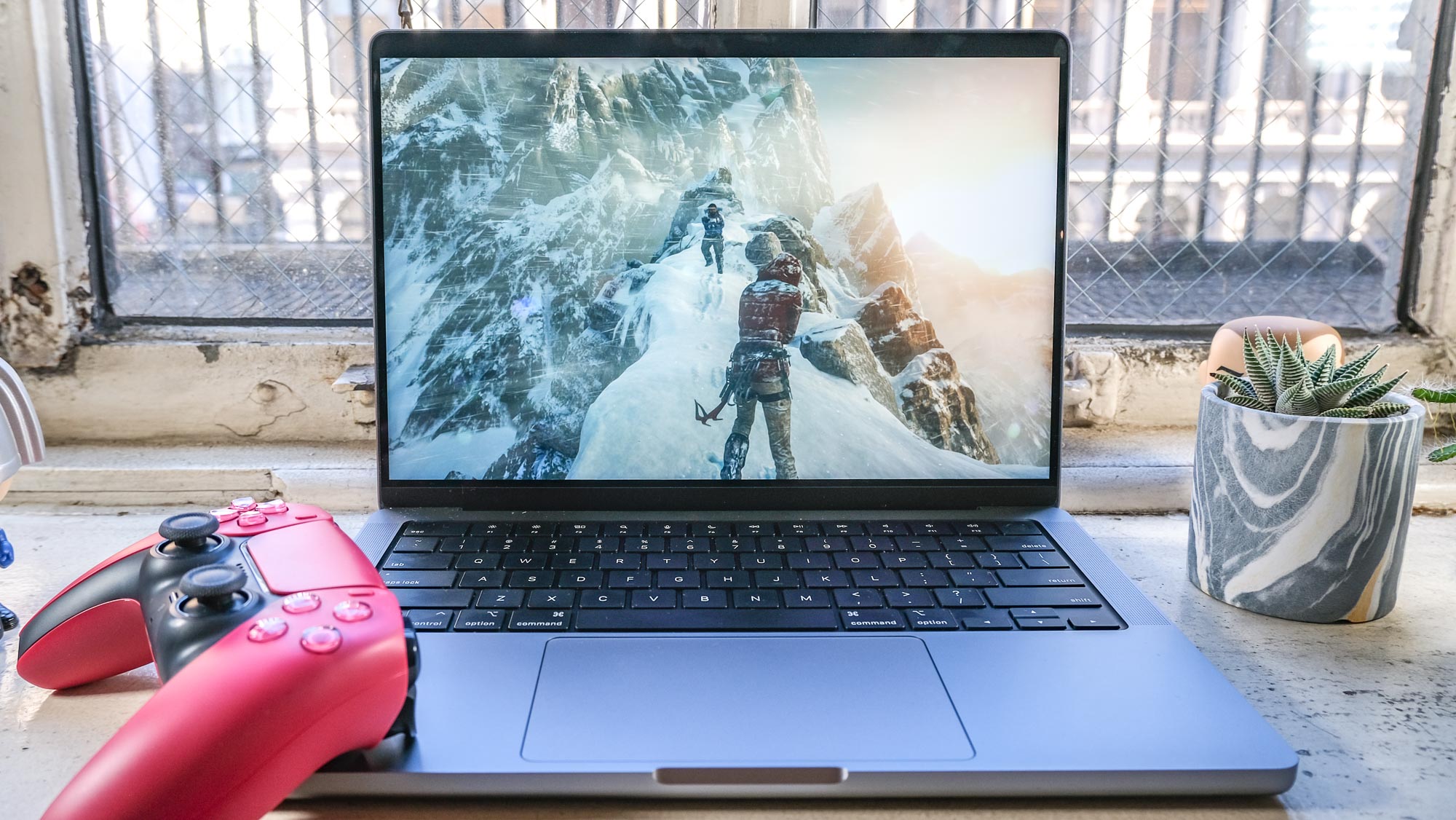
The 14-inch MacBook Pro ran Sid Meier's Civilization VI: Gathering Storm (at 1512x982) at 46 frames per second, a smoother rate than the 22 fps rate the XPS 13 (with Intel Iris Xe Graphics) had, though that ran at 1080p. The 16-inch MacBook Pro ran it (set to 1728 x 1080) at 46 fps. For context, 30 frames per second is playable, though we always love to see a higher mark. The Nvidia RTX 3050 Ti GPUs in the Surface Laptop Studio (66 fps) and Dell XPS 15 (67 fps) enabled smoothness that kicked everyone's butt here.
The M1 Pro deficiencies against the M1 Max showed up in the 3DMark Wild Life Extreme Unlimited test. There the M1 Pro's 16-core GPU earned a score of 10,386 at 62.17 frames per second, while the 16-inch MacBook Pro (32-core GPU M1 Max) earned a 20,220 score at 121 frames per second.
MacBook Pro 2021 (14-inch) review: Battery life
- 14-inch MacBook Pro lasts over 14 hours on our test
- 6+ Hours longer than OLED XPS 13
The Apple Silicon era has been largely great for the MacBook Pro, delivering much longer endurance than in years past. That continues here.
The 14-inch MacBook Pro delivered all-day performance, lasting 14 hours and 9 minutes on the Tom's Guide web browsing-based battery test (set to 150 nits). For comparisons' sake, the Intel-based MacBook Pros — the 13-inch (10:21), 15-inch (also 10:21) and 16-inch (10:55) — all came in at shorter times.
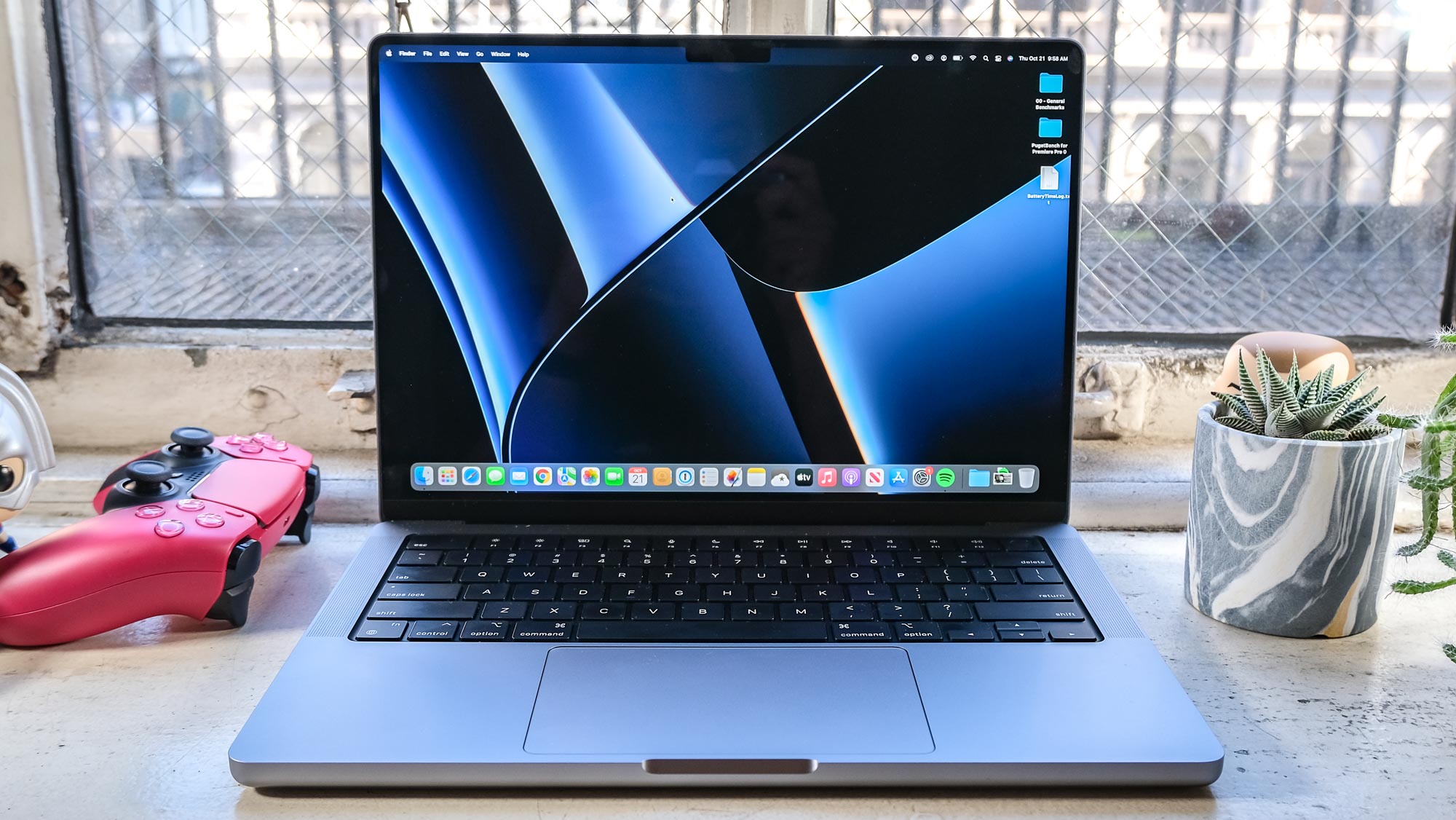
The first MacBook Pro with M1 (16:25) and the M1 Max 16-inch MacBook Pro (15:32) both lasted longer, while the Intel-based Dell XPS 13 with OLED (7:59), Dell XPS 15 with OLED (6:58) and AMD-based Razer Blade 14 (6:02) fared much worse. The Surface Laptop Studio (10:42) did better, but still didn't come close.
MacBook Pro (14-inch, 2021) review: Webcam
- Improved clarity in 1080p webcam
- Most competitors still have 720p webcams

Unfortunately, online video conferencing is a new normal, and Apple's recognized that here. The 14-inch MacBook Pro (and its 16-inch sibling) have 1080 webcams, a leap up from the grainy 720p cams in the Dell XPS 13 and XPS 15, 2020 MacBook Pro and Razer Blade 14 (kudos to Microsoft for putting a 1080p webcam in the Surface Laptop Studio).
You'll see video I shot on both cameras in my review video above, and here's a comparison between selfies shot on the new 14-inch MacBook Pro's webcam and the 720p camera in the Intel-based 2020 MacBook Pro.

I don't even need to tell you which is which. The left selfie is so much brighter and clearer, with more of my hair visible for starters (on the right, a lot of detail is lost in black sections). My skin is also much clearer on the left, as are my clear glasses.
It's great that Apple decided to make this change, as we still live in a world filled with remote-work experiences, where calls on Google Meet, Zoom, Skype and Teams have replaced meetings.
MacBook Pro (14-inch, 2021) review: Keyboard and touchpad
- Excellent and comfortable typing experience
- The Touch Bar is gone, and we're ready to throw a party
The Magic Keyboard in the 14-inch MacBook Pro 2021 is comfortable and enables speedy typing. Its keys provide a decent amount of physical feedback, and testing it out on the 10fastfingers typing test, I click-clacked my way to 77 words per minute (with a 96% accuracy rate), near my 80 wpm external keyboard average. I also noted that its 5.1 x 3.1-inch glass Force Touch trackpad is accurate and provides smooth scrolling.
There’s more to the new MacBook Pro’s keyboard than just the typing experience, though. Apple’s made other significant changes that have us exclaiming "out with the new and in with the old!" Yes, in 2021, we're celebrating physical keys on a keyboard. Not only has Apple stuck with the Magic Keyboard mechanism design it introduced in 2019 and 2020 (which replaced the notoriously unreliable and class action-lawsuit inspiring Butterfly keyboard), but they also threw out another relatively-recent 'innovation.'
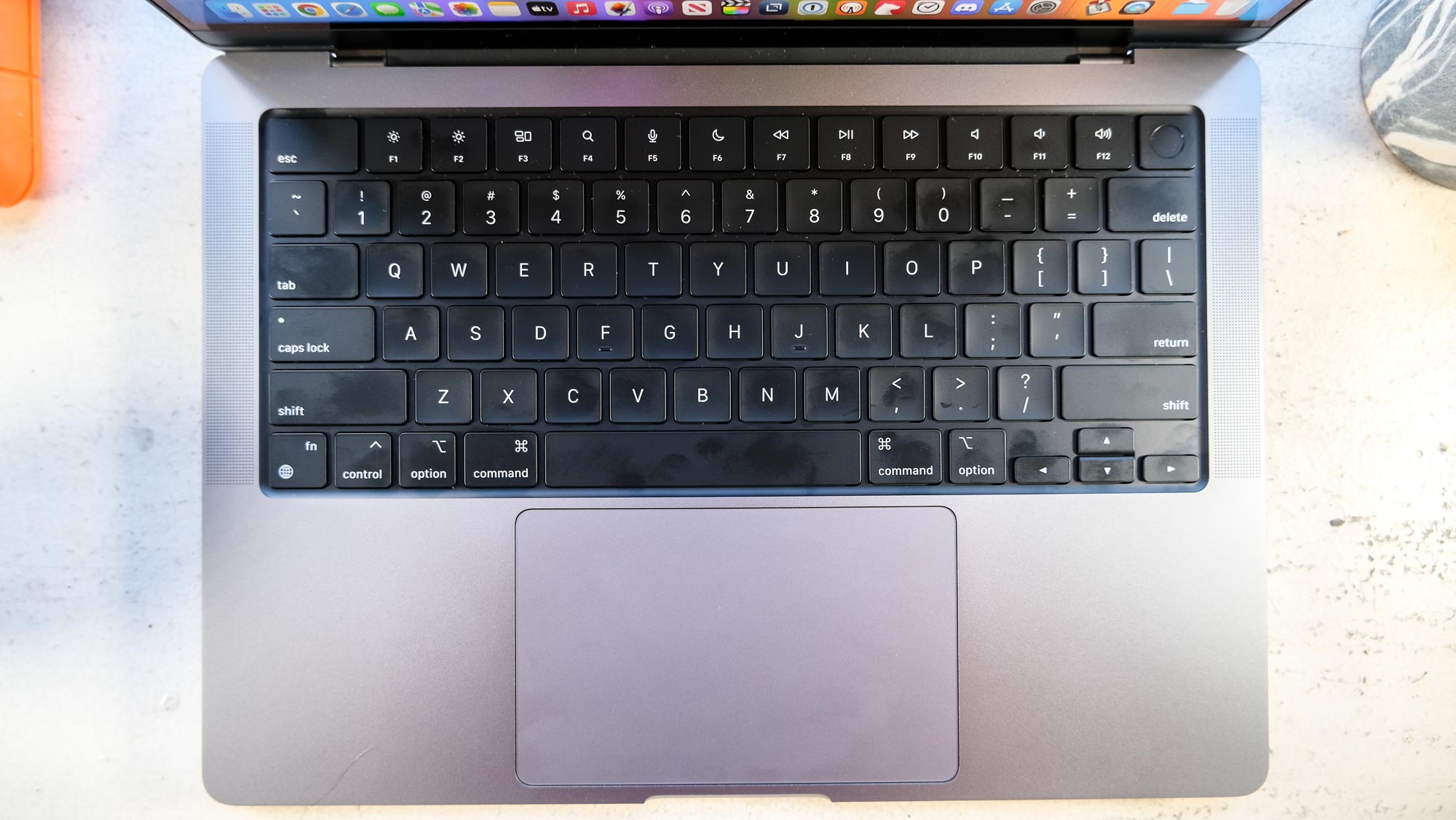
The Touch Bar, a thin OLED touchscreen (the only kind Apple's put in a laptop), was introduced in 2016. It had 'software buttons' that would appear in tandem with specific apps. Getting a phone call? You could start or hang up with the Touch Bar. Want to send an emoji? The Touch Bar had you covered.
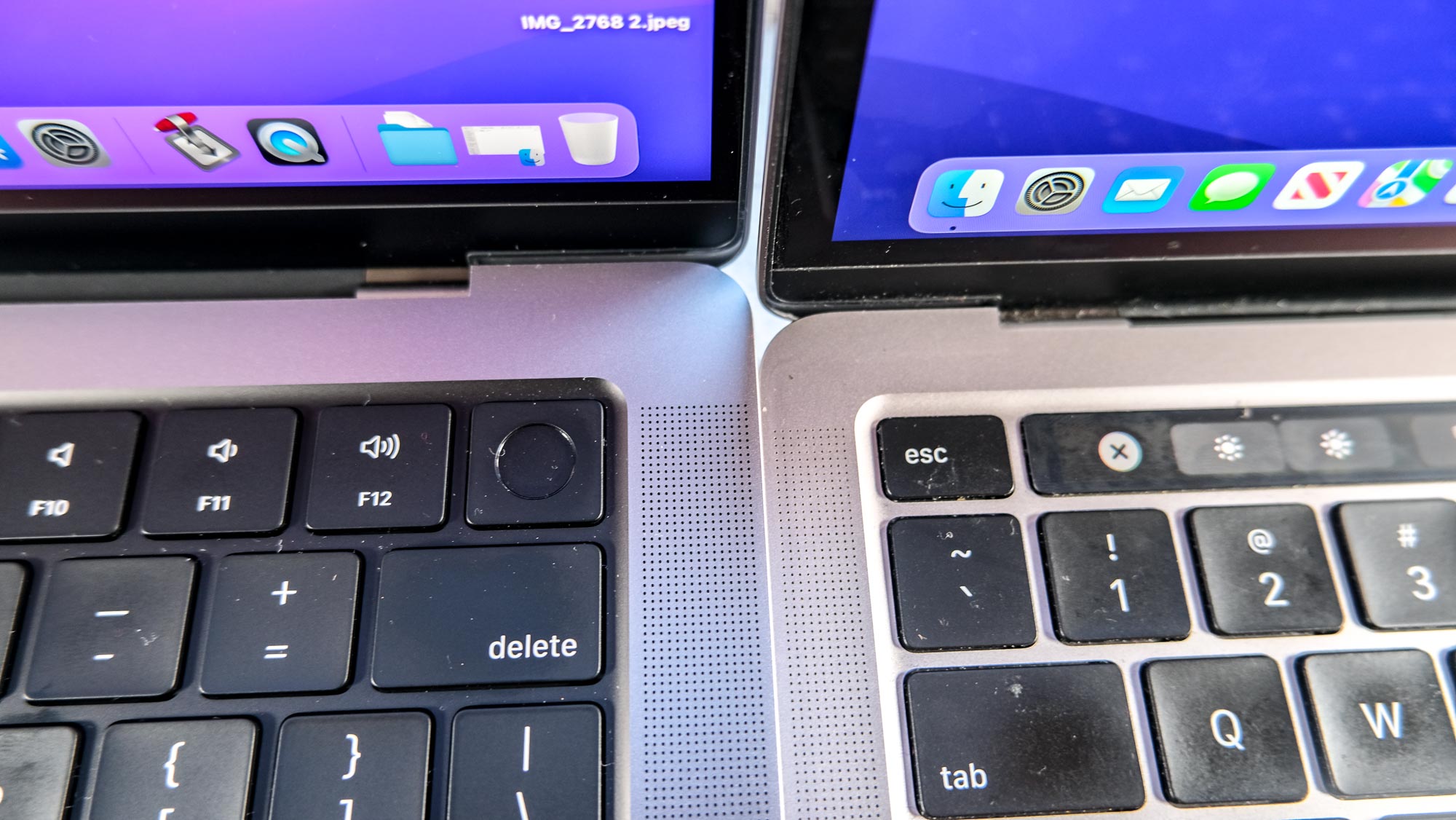
But the Touch Bar never truly justified its existence, and Apple replaced it in these new MacBook Pros. In its place, we have a row of full-height Function keys (F1-F12, the brightness, multimedia and other shortcut keys), an escape key and a power button that features Touch ID biometric security for confirming your identity in order to unlock the system, open a password manager or use ApplePay.
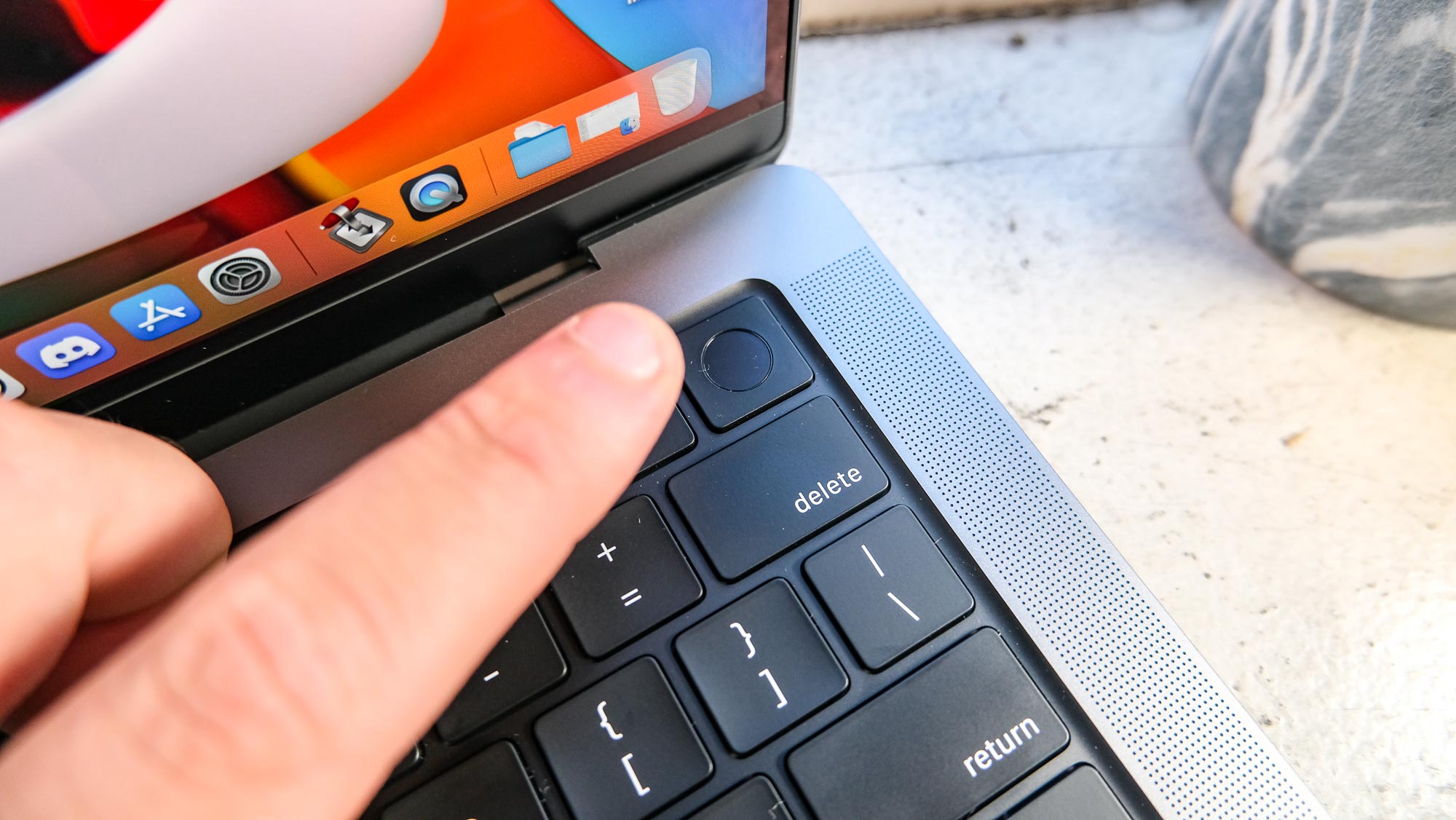
This change is more than welcome if you ask me, as I often found my fingers accidentally actuating the Touch Bar by merely grazing its surface.
MacBook Pro 2021 (14-inch) review: Audio
- Six-speaker setup impresses
- Improved audio quality in microphones
Apple's audio engineers continue to do marvelous work, now packing a strong and sweet-sounding six-speaker array into the 14-inch MacBook Pro 2021. When I turned on Frank Ocean's moody single "Swim Good," I couldn't stop myself from bobbing along to the thumping bass.
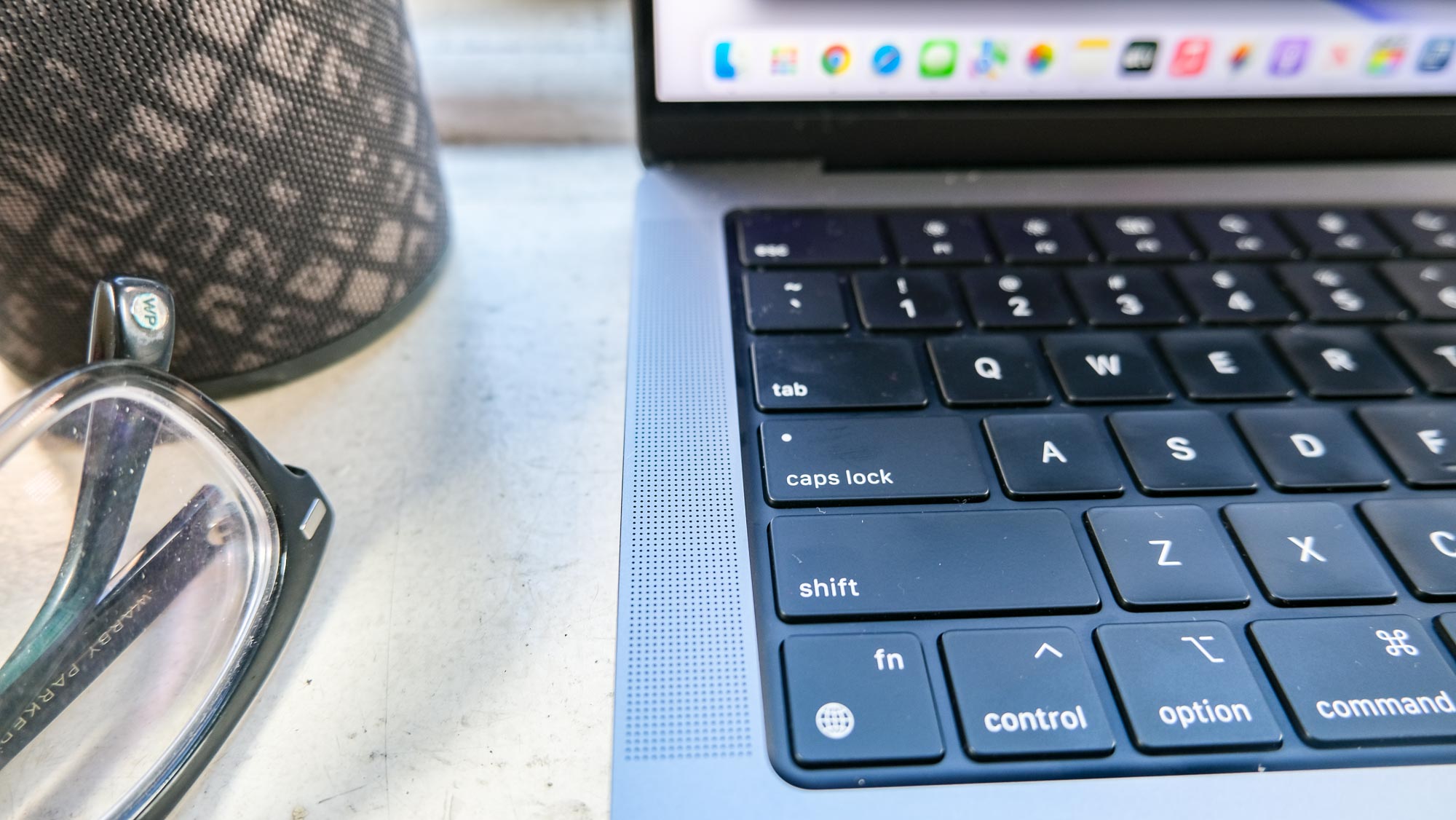
The trio of built-in microphones have been improved for higher sound quality, something I saw for myself when recording videos in Quicktime.
MacBook Pro 2021 (14-inch) review: Heat
- Gets slightly warm
- But doesn't get too hot
As I've tested the new MacBook Pro, I've noticed it get a little warm at most, nothing to even remark about. After we streamed 15 minutes of Full HD video on it, our heat gun picked up temperatures below 95 degrees Fahrenheit on its touchpad (85 degrees), keyboard and underside (both 89.5 degrees).
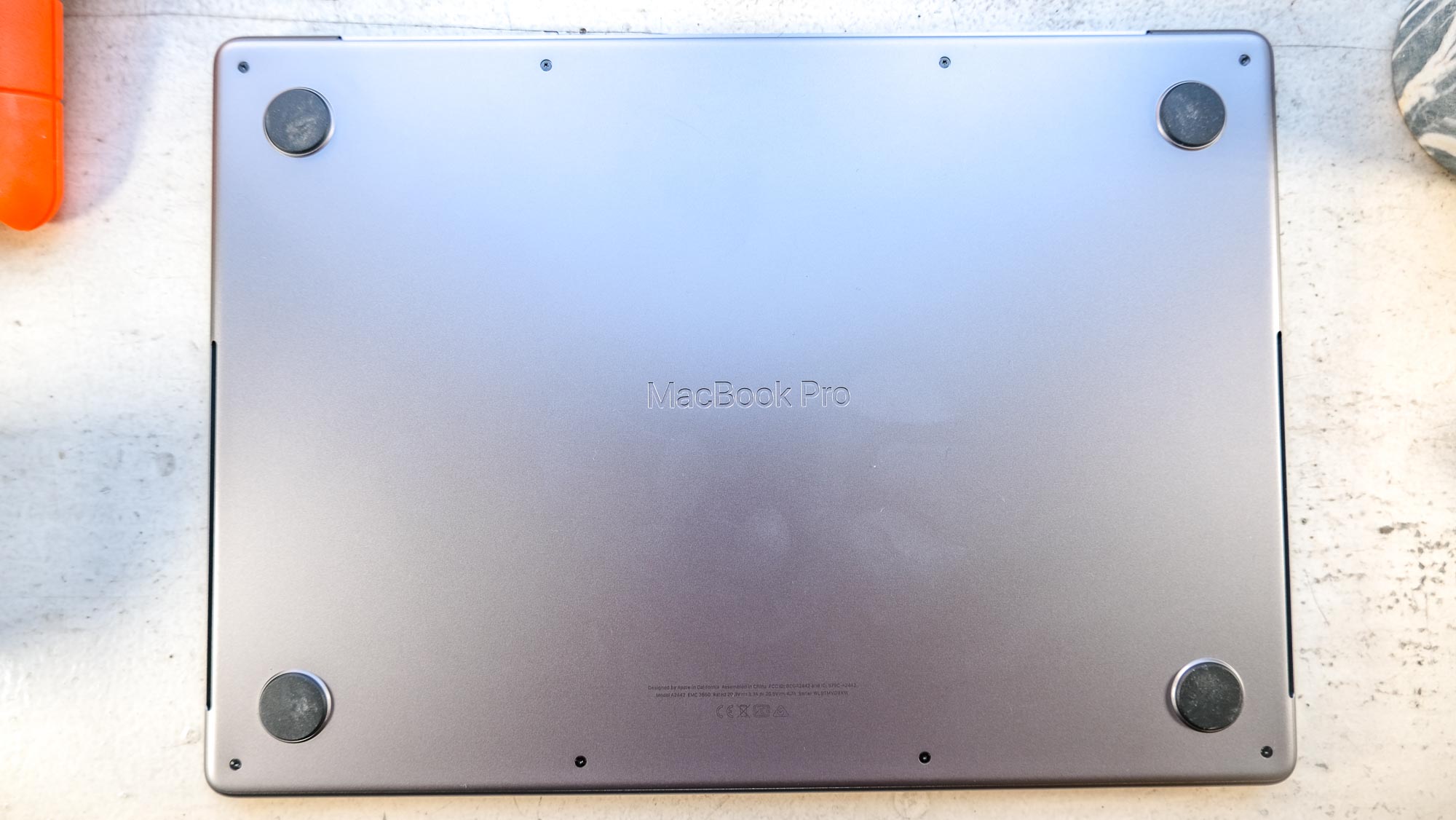
MacBook Pro 2021 (14-inch) review: Software and apps
- macOS 12 is stable, but announced features have been delayed
- Live Text is the coolest software feature Apple's made in years
macOS Monterey, aka macOS 12, is the latest version of Apple's desktop operating system, and as someone who's been testing it on an M1 MacBook Air and a 2020 Intel MacBook Pro since the betas came out, I can say I'm fairly enamored with it. Apple's had to delay two marquee features — SharePlay and Universal Control — past the full final launch of Monterey, but it's still good.
First off, I've often had to remind myself that this is, in fact, a beta. That's how stable this release is (though your mileage may vary, depending on your favorite apps). Without those two major features, Apple's admittedly got fewer big reasons to make you download it. But, that said, LiveText — which lets you select and copy text in images — is truly amazing, and something that I truly believe would make people want to download it ASAP. As you can see with this set-list I got from a recent concert, Live Text makes it easy for me to export that text on that sheet, saving me the time of typing it out myself.
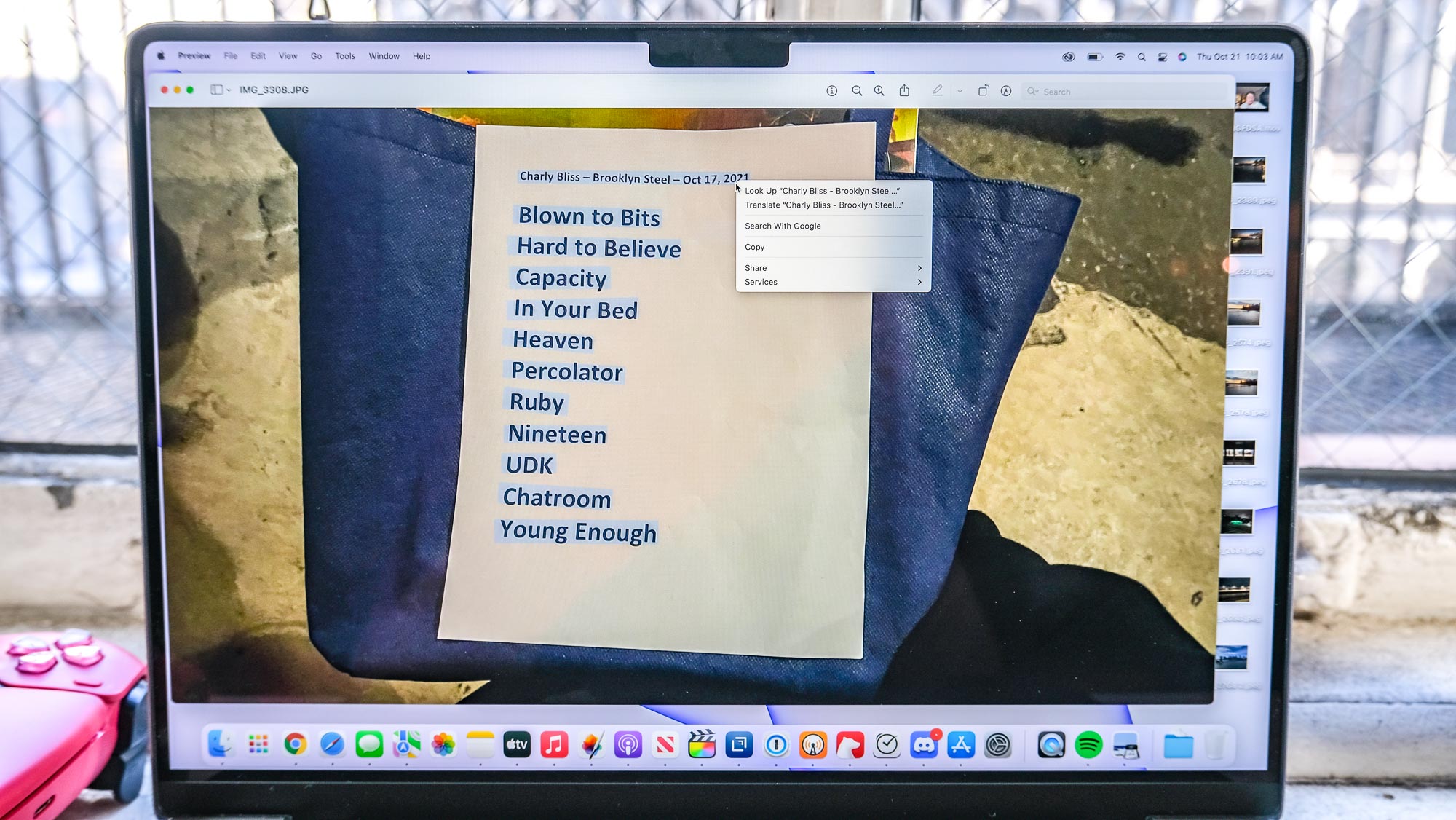
As much as I love macOS, though, you may be forced to spend $99 on this app if you want to live stream on your Mac. And of course, downloading some of the other best Mac apps will further enhance your experience.
One of those apps, Rectangle, is the missing link for macOS, and the one Mac app I can't go without.
MacBook Pro 2021 (14-inch) review: Verdict
I've been waiting for this MacBook Pro 2021 (14-inch) review for a very long time. I last bought a Mac in 2012, when the first Retina Display MacBook Pro arrived. And then I didn't need a MacBook until around 2016 and 2017, right when Apple switched to a controversial keyboard that felt too shallow and took away MagSafe and those valuable ports.
So, I made my 2012 MacBook Pro stretch. But it's barely been able to hold much of a battery charge, the performance has slowed significantly, and Apple's new OS updates haven't supported it. I started to wonder what operating system my next computer would run, even considering Windows machines. But then the Butterfly keyboard switch went extinct, news of the returning ports leaked and rumors of the Touch Bar's demise spread. And I got very excited, even more so as Apple delivered the goods. Seemingly, Apple listened to years of pro user complaints, because this is the laptop that we've been asking for.
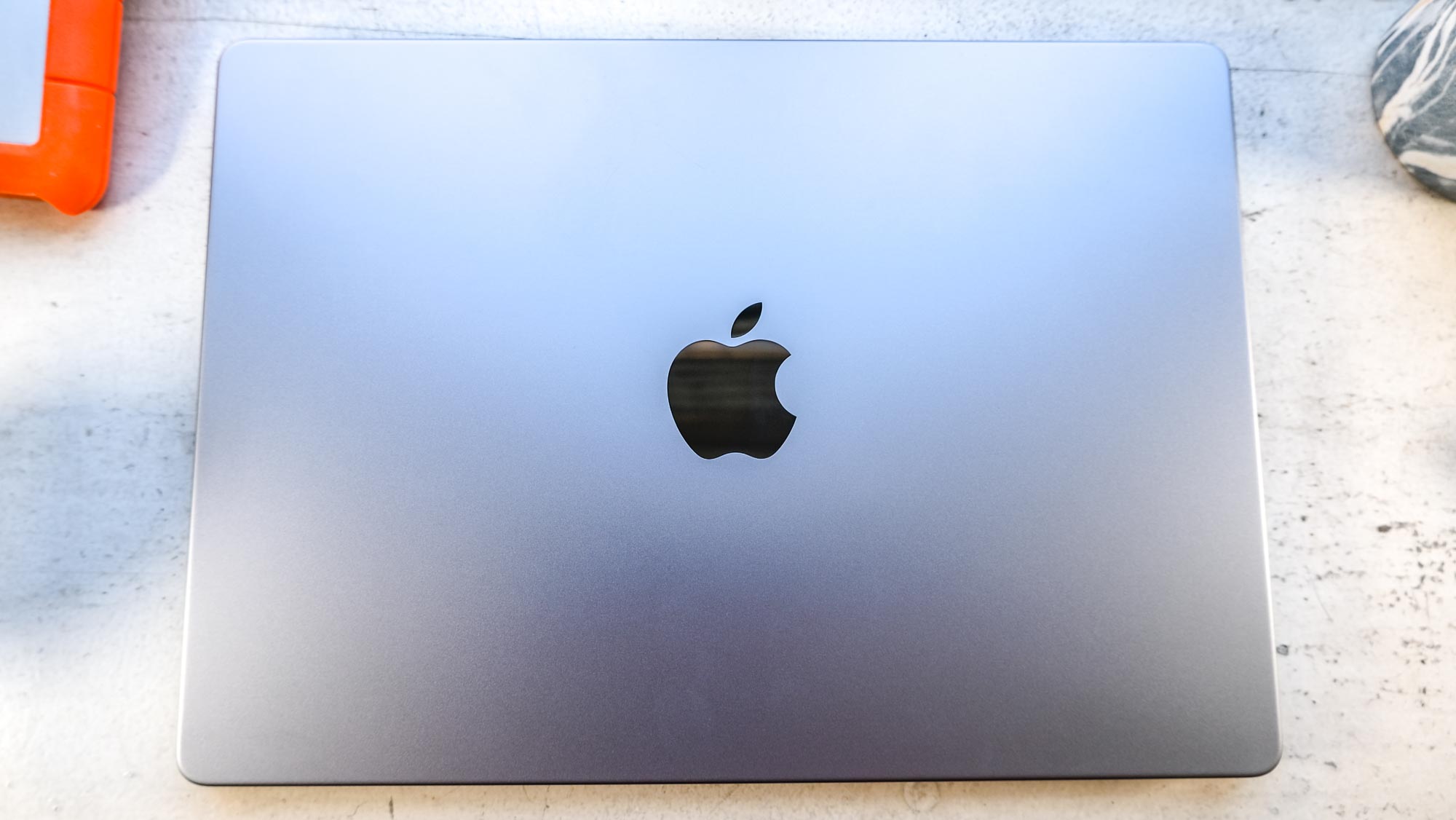
On top of that, the 14-inch MacBook Pro 2021 features amazing performance from the super-fast M1 Pro (or the faster M1 Max if you pay more), a gorgeous Liquid Retina XDR display that's both bright and speedy, and the thinner bezels it's long needed.
You could have similarly thin bezels with the Dell XPS 13 with OLED, and they'd cost you a lot less. An XPS 13 with similar specs as the MacBook Pro we tested is more than $800 less (at $2,069), but its battery life is far shorter, it isn't as fast and its display isn't as bright; check out our MacBook Pro 14-inch vs Dell XPS 13 face-off for a full comparison between the two.
Want great graphics performance for gaming? The Surface Laptop Studio is similarly priced, but you'll lose battery life and general performance when compared to the 14-inch MacBook Pro, while the XPS 15 we tested is about $400 less, but a bit heavier and has much less endurance on a single charge.
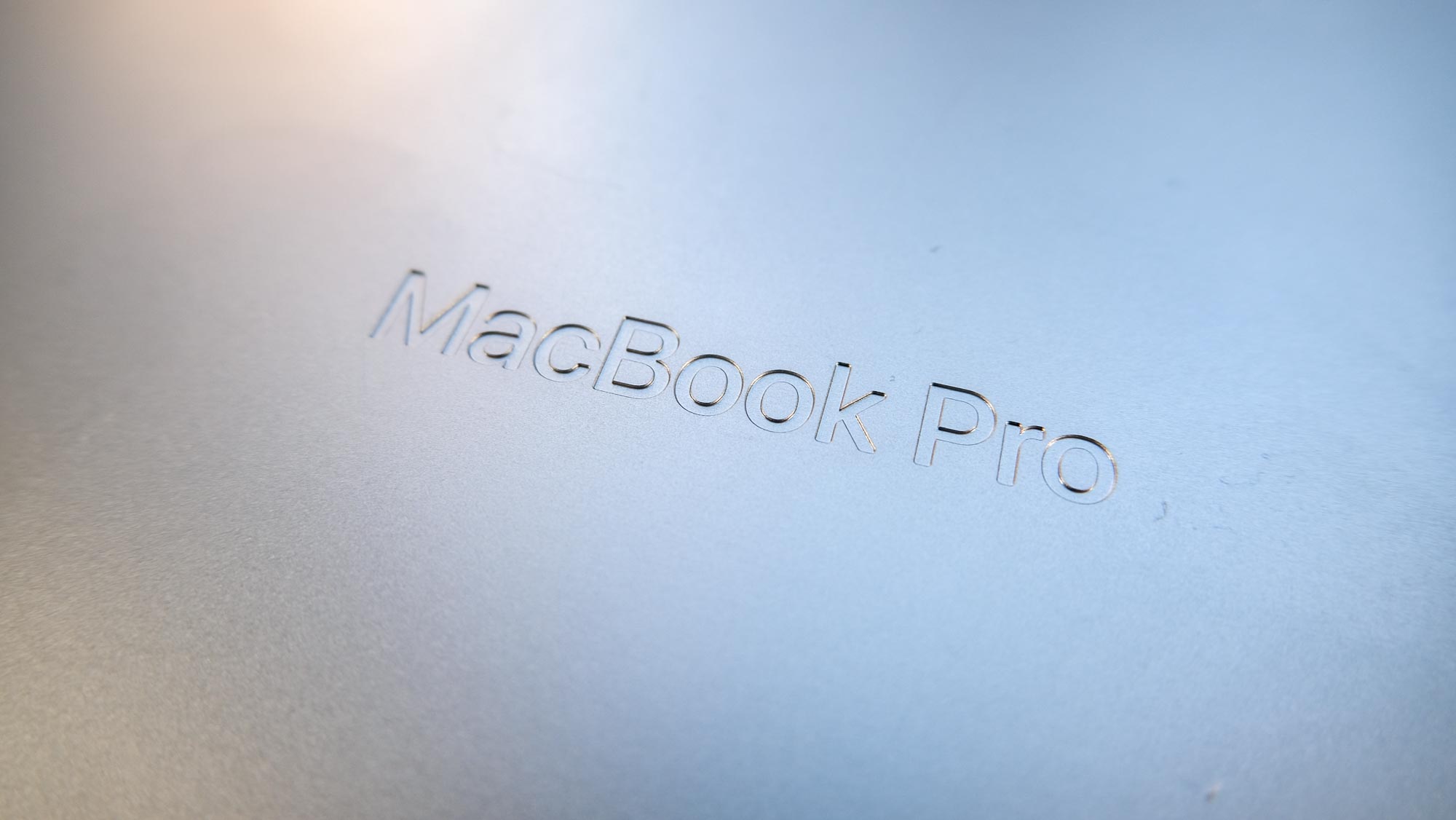
You could stay in the Mac world, and save $700 and get longer battery life with the 13-inch MacBook Pro, but you probably won't want to if you ever see the thinner bezels of the 2021 MacBook Pros.
We'd love to see a MacBook Pro with these ports at a more affordable price, but that's not in the cards right now. The MacBook Air M2 comes close thanks to its MagSafe charger, but it still lacks an HDMI port and SD card reader. All that said, the new 14-inch MacBook Pro is pretty much exactly the laptop that many have waited for and even dreamed of. With a notch on top.

Henry was a managing editor at Tom’s Guide covering streaming media, laptops and all things Apple, reviewing devices and services for the past seven years. Prior to joining Tom's Guide, he reviewed software and hardware for TechRadar Pro, and interviewed artists for Patek Philippe International Magazine. He's also covered the wild world of professional wrestling for Cageside Seats, interviewing athletes and other industry veterans.
